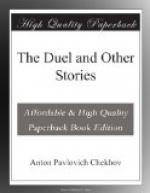On the further bank some unknown persons made their appearance near the drying-shed. The flickering light and the smoke from the camp-fire puffing in that direction made it impossible to get a full view of them all at once, but glimpses were caught now of a shaggy hat and a grey beard, now of a blue shirt, now of a figure, ragged from shoulder to knee, with a dagger across the body; then a swarthy young face with black eyebrows, as thick and bold as though they had been drawn in charcoal. Five of them sat in a circle on the ground, and the other five went into the drying-shed. One was standing at the door with his back to the fire, and with his hands behind his back was telling something, which must have been very interesting, for when Samoylenko threw on twigs and the fire flared up, and scattered sparks and threw a glaring light on the shed, two calm countenances with an expression on them of deep attention could be seen, looking out of the door, while those who were sitting in a circle turned round and began listening to the speaker. Soon after, those sitting in a circle began softly singing something slow and melodious, that sounded like Lenten Church music. . . . Listening to them, the deacon imagined how it would be with him in ten years’ time, when he would come back from the expedition: he would be a young priest and monk, an author with a name and a splendid past; he would be consecrated an archimandrite, then a bishop; and he would serve mass in the cathedral; in a golden mitre he would come out into the body of the church with the ikon on his breast, and blessing the mass of the people with the triple and the double candelabra, would proclaim: “Look down from Heaven, O God, behold and visit this vineyard which Thy Hand has planted,” and the children with their angel voices would sing in response: “Holy God. . .”
“Deacon, where is that fish?” he heard Samoylenko’s voice.
As he went back to the fire, the deacon imagined the Church procession going along a dusty road on a hot July day; in front the peasants carrying the banners and the women and children the ikons, then the boy choristers and the sacristan with his face tied up and a straw in his hair, then in due order himself, the deacon, and behind him the priest wearing his calotte and carrying a cross, and behind them, tramping in the dust, a crowd of peasants—men, women, and children; in the crowd his wife and the priest’s wife with kerchiefs on their heads. The choristers sing, the babies cry, the corncrakes call, the lark carols. . . . Then they make a stand and sprinkle the herd with holy water. . . . They go on again, and then kneeling pray for rain. Then lunch and talk. . . .
“And that’s nice too . . .” thought the deacon.
VII
Kirilin and Atchmianov climbed up the mountain by the path. Atchmianov dropped behind and stopped, while Kirilin went up to Nadyezhda Fyodorovna.




